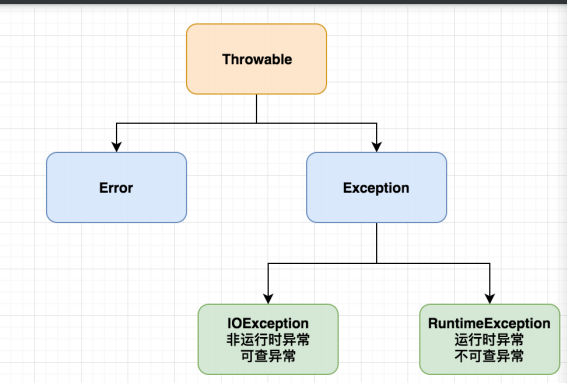异常Exception
1.异常Exception
什么是错误:程序运⾏时发⽣的不被期望的事件,阻⽌了程序按照预期正常执⾏
常⻅程序错误分三类
编译错误:新⼿最常⻅,没遵循语法规范
运⾏时错误:程序在执⾏时
逻辑错误:程序没有按照预期的逻辑顺序执⾏
Java.lang软件包中有⼀个java.lang.Throwable类,这个类是java中所有错误和异常的超类,Throwable类有两个⼦类,Error与 Exception
Error:是Throwable 的⼦类,包含⼤量⼦类,出错后程序⽆法处理,如OutOfMemoryError,
Exception:是Throwable 的⼦类,包含⼤量⼦类,程序本身可以处理的异常,如ArrayIndexOutOfBoundException
两大类
可查异常(编译器要求必须处置的异常):RuntimeException及其⼦类以外,其他的 Exception类及其⼦类, 如 IOException和ClassNotFoundException
不可查异常(编译器不要求强制处置的异常): 包括运⾏时异常(RuntimeException与其 ⼦类)和错误(Error),如ArrayIndexOutOfBoundsException

2.内置异常体系分类和核⼼⽅法
java内置异常
可查异常(必须要在⽅法⾥⾯捕获或者抛出)
ClassNoFoundException 应⽤程序试图加载类,找不到对应的类
IllegalAccessException 拒绝访问⼀个类的时候
NoSuchFieldExcetion 请求的变量不存在
NoSuchMethodException ⽅法不存在
不可查异常
ArrayIndexOutOfBoundsException 数组索引越界
ClassCastException 强制失败抛出异常
NullPointerException 需要对象的地⽅使⽤ null 时,抛出该异常
NumberFormatException 将字符串转换成⼀种数值类型,但该字符串不能转换为适当 格式时,抛出该异常
Throwable类核⼼⽅法
public String getMessage():异常的详细信息
public Throwable getCause():异常原因
public void printStackTrace():打印错误的堆栈信息,即错误输出流,可以看到错误原因和所在位置
public StackTraceElement [] getStackTrace():堆栈层次的数组,下标为0的元素代表栈顶,最后⼀个元素代表⽅法调⽤堆栈的栈底
package day1; public class ExceptionTest { public static void main(String [] args){ try{ int result = 25/0; System.out.println(result); }catch (Exception e){ String msg = e.getMessage(); StackTraceElement [] arr = e.getStackTrace(); e.printStackTrace(); } } }
Try Catch 异常捕获
异常处理之捕获
语法
try{ // 可能发⽣异常的代码 }catch(AExceptionName e){ //出异常的时候处理 }catch(BExceptionName e){ }fianall{ }
try后面跟一个或多个catch块,或一个finally,或两者的组合
catch不能独立于try而单独存在
如果代码没有对应的异常类进行捕获,则默认打印异常堆栈
package day1; public class Exceotion2Test { public static void main(String [] args){ test(); } public static void test(){ try{ Student student = new Student(); student.setAge(-1); }catch (NullPointerException e){ System.out.println("出异常了 NullPointerException"); }catch (IllegalArgumentException e){ System.out.println("出异常了 IllegalArgumentException"); } } }
finally 和多重捕获
⼀个 try 代码块后⾯跟多个 catch 代码块的情况就叫多重捕获
语法
try{ // 可能发⽣异常的代码 }catch(ExceptionName1 e1){ //出异常的时候处理 }catch(ExceptionName2 e2){ //出异常的时候处理 }
代码中发⽣异常,异常被抛给第⼀个 catch 块, 如果不匹配则继续往下⼀个catch进⾏传递
finally关键字
⽤来创建在 try 代码块后⾯执⾏的代码块
finally 代码块中的代码总会被执⾏
⼀般⽤于资源回收释放等操作
语法
try{ // 可能发⽣异常的代码 }catch(ExceptionName1 e1){ //出异常的时候处理 }finally{ //肯定执⾏的代码 }
或者
try{ // 可能发⽣异常的代码 }finally{ //肯定执⾏的代码 }
TestException类
package day1; public class TestException3 { public static void main(String [] args){ int result = divide(25,0); System.out.println("最终结果"+result); } public static int divide(int num1, int num2){ try{ int result = num1/num2; return result; }catch (Exception e){ System.out.println("出异常"); }finally { System.out.println("finally执行了"); return -2; } } }
三者的组合
try,catch和finally块有两种可能的组合:try-catch-finally或try-finally。
5.异常处理之throws/throw关键词
代码出异常常⻅的处理⽅法
try catch捕获
throws 声明异常 往外抛出
语法:throws⼦句放在⽅法参数列表的右括号之后,⼀个⽅法可以声明抛出多个异常, 多个异常之间⽤逗号隔开。
public class Main { public static void readChar() throws IOException,RemoteException { int input = System.in.read(); } }
try catch中捕获了异常,处理方法
当前捕获⾃⼰处理
捕获⾃⼰处理然后继续往外⾯抛异常
语法
throw new ExceptionName("异常信息");
例子
throw new IOException("File not found");
总结:当抛出⼀个被检查的异常,我们必须使⽤try-catch块来处理它,或者在⽅法声明中使⽤ throws⼦句继续往外抛
TestException类
package day1; public class TestException { public static void main(String [] args)throws Exception{ int result = divide(25,0); } public static int divide(int num1, int num2)throws Exception{ try { int result = num1/num2; return result; }catch (Exception e){ System.out.println("出异常了"); throw new Exception("参数异常"); } } }
自定义异常
为什么要使⽤⾃定义异常:当前JDK内置的异常不满⾜需求,项⽬会出现特有异常。⾃定义异常可以让业务更清晰
如何进⾏⾃定义异常:异常都是继承⾃Exception类,所以我们要⾃定义的异常也需要继承这个基类。
UserNotEnoughException类
package day1; public class UserNotEnoughException extends Exception{ private int code; private String msg; public UserNotEnoughException(){ super(); } public UserNotEnoughException(int code, String msg){ super(msg); this.code = code; this.msg = msg; } public void setCode(int code){ this.code = code; } public int getCode(){ return code; } public String getMsg(){ return msg; } public void setMsg(String msg){ this.msg = msg; } }
CustomExceptionTest类
package day1; public class CustomExceptionTest { public static void main(String [] args){ try{ test(); }catch (NullPointerException e){ e.printStackTrace(); }catch (UserNotEnoughException e){ int code = e.getCode(); String msg = e.getMsg(); e.printStackTrace(); System.out.println("code="+code+",msg="+msg); } } public static void test()throws UserNotEnoughException{ throw new UserNotEnoughException(-1,"人员不够"); } }


 浙公网安备 33010602011771号
浙公网安备 33010602011771号